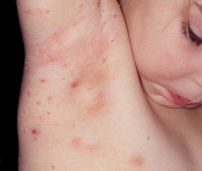

Molluscum contagiosum is an infection caused by a poxvirus that causes lesions (growths) that can appear on the body, either alone or in groups. The lesions, called Mollusca, are small, raised, and usually white, pink, or flesh-colored with a dimple or pit in the center. They may become itchy, sore, red, and swollen. Mollusca can show up anywhere on the body, including the face, neck, arms, legs, abdomen, and genital area. The lesions are rarely found on the palms of the hands or the soles of the feet.
You can get molluscum if you touch the lesions of someone who has it. It can also spread when you touch items that have the virus on it. Examples include towels, clothing, toys, or pool equipment used by someone who has molluscum.
Molluscum is usually not dangerous, and you typically don't need treatment if you get it. The most common complication is a bacterial infection if lesions are scratched or broken. A bacterial infection can be serious for people who are immunocompromised and may need treatment.
Anyone can get infected, but molluscum is most common in children between 1 and 10 years old. This means that many kids in daycare centers and schools may get it.
If you notice lesions on a child's skin, let their parents know. Your daycare center may require a doctor's note, and only a healthcare professional can diagnose molluscum contagiosum.
Covering the lesions will protect other children and adults from getting molluscum. It will also keep the child from touching and scratching the lesions, which could spread the infection to other parts of the body or cause bacterial infections.
Lesions not covered by clothing should be covered with a bandage. Change the bandage when obviously dirty.
If a child with lesions in the underwear/diaper area needs assistance going to the bathroom or needs diaper changes, then lesions in this area should be bandaged too if possible.
Remind kids to wash their hands often. CDC has information and resources about washing hands in educational settings.
Parents and others often ask if molluscum can spread in swimming pools. People also wonder if it can spread by sharing swimming equipment, pool toys, or towels.
Some investigations report that spread of molluscum contagiosum happens in swimming pools. However, it's never been proven how this might happen. It's more likely that activities related to swimming are the cause. For example, the virus might spread from one person to another if they share a towel, kickboard, goggles, or toys.
If a person with molluscum is going swimming, they should:
People with open sores from molluscum or other causes shouldn't go into swimming pools because the sores could get infected by many kinds of bacteria or viruses in the water.
Public pool administrators should carefully consider whether or not to keep kids with molluscum out of public pools. Children may need the pool for exercise, social outings, or during camp. Excluding children with molluscum, which is typically not a dangerous infection, could cause embarrassment and create social stigma.
If a public pool does implement a no-molluscum policy, the diagnosis of molluscum contagiosum should be made by a healthcare provider. All participating children should be subject to the same screening physical exam, which would include a thorough skin examination as well.
Disinfecting pool equipment
Thorough disinfection and drying of kickboards and other pool equipment that might touch lesions should reduce the likelihood of molluscum contagiosum transmission.
There is no EPA-registered disinfectant approved to kill molluscum contagiosum virus. Household bleach solutions and other EPA-registered surface disinfectants can effectively decontaminate surfaces. Follow the manufacturer's recommendations for concentration, contact time, and care in handling.